Willys MB - Myouth - Ricordi degli anni '70
Menu principale:
Willys MB
Modellismo > Automezzi > Willys MB
Willys MB
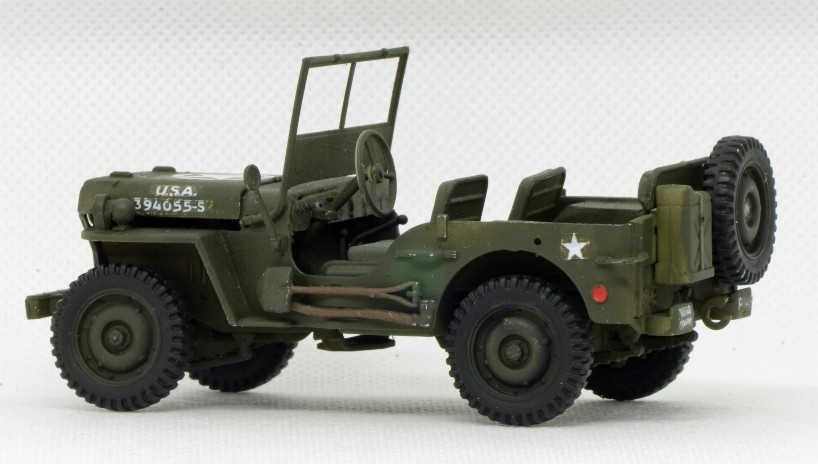
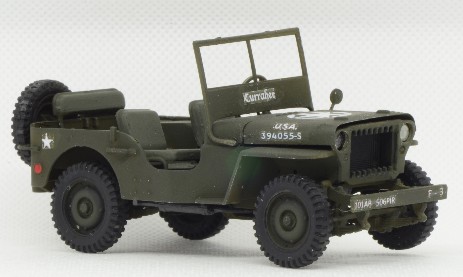
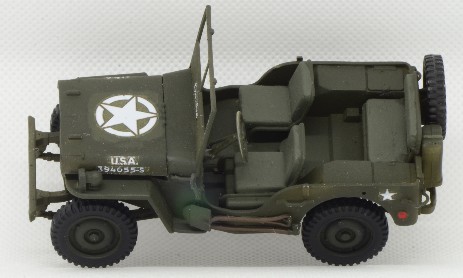
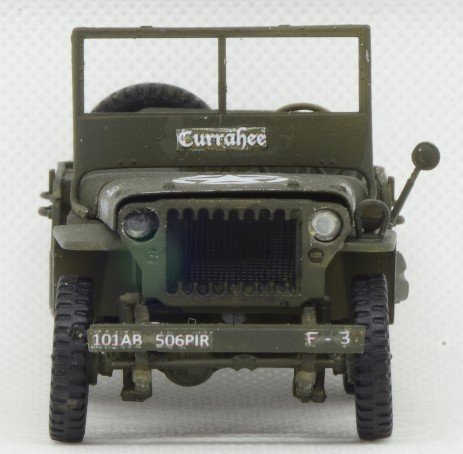
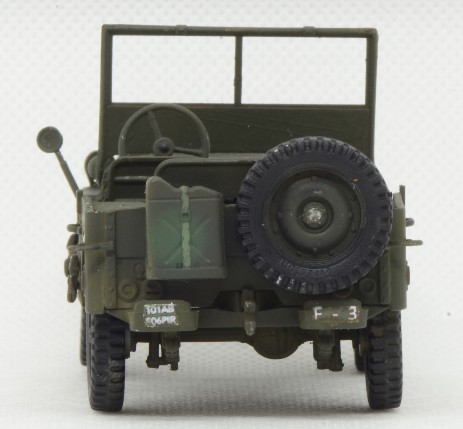
Il senso di questo modello
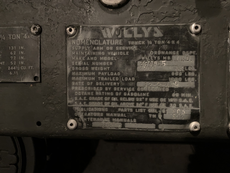
Ho una Willys MB, che mi accompagna da tanti anni in varie escursioni in montagna. E' ben tenuta, seppure colore ed insegne non siano storicamente molto rispondenti all'originale. Prima o poi ne faro' sistemare la carrozzeria, dandole un maggior "senso storico".
Questo modellino che ho trovato a casa (che in realtà si riferiva ad una versione diversa della MB, senza alcuna decalcomania) è stato il pretesto per provare a immaginare come potrò sistemare la mia vera jeep.
Tecnicamente si sarebbe potuto ottenere un miglior risultato nel montaggio, così come le decalcomanie che ho creato ad hoc potrebbero essere migliori, ma il divrtimento nel farla è stato grande.
Il numero di matricola sul cofano corrisponde a quello vero della mia MB: 394055

La vettura venne consegnata il 2 Dicembre 1944.
Non avendo idea del reparto e del teatro di guerra cui possa essere stata assegnata, ho immaginato che sia stata utilizzata da forze che si sono distinte nella guerra in Europa (il che è coerente con il fatto che io la abbia potuta acquistare qui).
Quindi le insegne che ho disegnato si riferiscono a:
- 101 Airborne
- 506 PIR (paracadutisti)
- Compagnia F
- Veicolo numero 3
In base alle ricerche che ho effettuato, avrebbe potuto effettivamente essere consegnata a questo reparto, ed in tal caso avrebbe avuto le insegne che ho riportato.
Unica differenza rispetto alla mia MB: la griglia frontale, che non è tagliata come quella del modello. Ma non sono stato capace di ricostruirla! :-)
Why this model

I personally have a Willys MB, that is a good companion since many years in various offroad trips on the italian mountains. It still is in good condition, even if its coluor and signs are not really in line with the real historical look. Sooner or later I will have it restored, giving her a better "historical look".
This model that I found at home (that actually was referred to a different version of the MB, and had no decals) has been the excuse to imagine how I could restore the real MB.
It could be better assembled of course, and also the decals that I made could be better, but it has been a great fun.
Serial number on the hood corresponds to the real SN of my Willys: 394055

It was shipped on December 2nd, 1944.
I have no idea to which Force nor division, and of which war theater it could hav been assigne, and for this reason I have liked to imagine that it was in force to troups that have distinguished themselves in Europe (that is coherent with the fact that I purchased it here).
So, the signs I have designed refer to:
- 101 Airborne
- 506 PIR (parachute)
- F Company
- Vehicle number 3
According to my researches, it could well have been shipped and used by this corp, and in this case its sign would have been such.
The only difference versus my real MB: its grill is not cut like the model, but I have not been able to reconstruct it! :-)
La Willys MB
Il veicolo da trasporto Utility truck ¼ t 4x4 jeep fu il veicolo costruito nel maggior numero di esemplari nel corso della Seconda guerra mondiale. Fu usato dalle forze armate degli Stati Uniti su tutti i teatri di guerra e fu ceduto in quantità notevoli a tutti gli alleati, diventando quindi il principale veicolo di collegamento anche per gli eserciti britannico, sovietico e francese. Fu utilizzato anche dalle forze dell'Asse, quando ebbero occasione di catturare veicoli ancora funzionanti.
Il nome "jeep" è dato dalla pronuncia dell'acronimo GP che sta per General Purpose (usi generali).
Successivamente alla Seconda guerra mondiale il termine jeep indicò genericamente qualsiasi veicolo militare leggero non blindato con un aspetto simile alla jeep originale.
Origini
La necessità di veicoli militari leggeri con quattro ruote motrici fu riconosciuta nell'ambito dell'US Army fin dal 1935, quando Arthur W. Herrington (che era stato ingegnere nel Quartermaster Corps) realizzò un veicolo con carico utile di mezza tonnellata, chiamato "Darling" per l'artiglieria, dove fu utilizzato in numero limitato di esemplari come "contact team vehicle". Le necessità della fanteria tuttavia erano orientate verso veicoli di dimensioni minori, dato che un veicolo come il Darling pesava circa 1800 kg (4000 lb) , mentre erano richiesti veicoli del peso di circa 700 kg (1500 lb) per poter essere spinti a mano in caso di guasto. In base a queste considerazioni nel giugno del 1940 il Quartermaster Corps emise le specifiche per un veicolo da ricognizione 4x4 del peso di 585 kg, richiedendo ai fabbricanti di autoveicoli di predisporre un prototipo per la fine di luglio. L'unica compagnia che fu in grado di soddisfare le richieste dell'esercito fu la American-Bantam che produsse un veicolo che, tuttavia, non rientrava nei limiti di peso, non realistici per la tecnologia dell'epoca, previsti.
L'esercito statunitense aveva fornito i disegni costruttivi del veicolo anche alla Willys ed alla Ford, senza l'autorizzazione della Bantam, quindi, nel novembre dello stesso anno, la Willys e la Ford presentarono i loro prototipi (chiamati rispettivamente Quad e Pygmy), molto simili a quello della Bantam. Quando finalmente l'esercito emise gli ordini definitivi per i primi 8000 veicoli, i veicoli di serie avevano modificato il loro aspetto ed il loro nome: la Jeep Bantam era il 40 BRC, il veicolo Willys era il modello MA ed il veicolo Ford il GPW.
Tuttavia nel luglio 1941 l'esercito si orientò definitivamente sul progetto Willys ed emanò contratti per questa ditta e per la Ford, eliminando totalmente la Bantam dalla produzione del veicolo, dandole solo un contratto per la produzione dei rimorchi.
Tecnica
Esteriormente la jeep era un veicolo estremamente rustico, in pratica solo una piattaforma su quattro ruote con un cofano a forma di parallelepipedo, con l'abitacolo appena protetto da barriere laterali che non superavano in altezza il cofano. Il parabrezza, costituito da due vetri sostenuti da un telaio, generalmente era abbattibile. L'uso principale, come veicolo da collegamento e, secondariamente, da ricognizione, non prevedeva particolari cure per la carrozzeria, tanto che furono studiate modifiche per realizzare la carrozzeria in compensato, per ridurre il consumo di acciaio (più utile all'industria pesante), comunque, considerando che la jeep aveva anche funzioni di trasporto fuoristrada per ufficiali superiori furono effettuati diversi tentativi, talvolta con modifiche direttamente nei reparti, per fornirla di una carrozzeria chiusa. Tipico della jeep, nella versione finale, era la griglia del radiatore in lamiera stampata con i fari incorporati.
Il motore di serie della jeep era il Willys Mod 442, detto anche Go Devil, un motore alimentato a benzina (come quelli di tutti i veicoli dell'esercito statunitense), un quattro cilindri con testata a "L" a valvole laterali. La cilindrata era di 2196 cm3, ed il motore erogava 40 kW (54 HP) a 3700 rpm, la coppia massima era di 123 N·m (98 ft-lb) a 2000 rpm., il rapporto di compressione era di circa 6,5:1 adatto all'uso di benzine militari e a basso numero di ottano. La trasmissione, con giunti a U, avveniva tramite un cambio a tre marce e retromarcia, con riduttore-ripartitore centrale. La trazione era posteriore con le marce normali per l'uso stradale, modificabile tramite un comando a leva in trazione integrale, con marce normali o ridotte per l'impiego in fuoristrada.
Gli ammortizzatori erano idraulici, indipendenti sulle quattro ruote e le sospensioni erano a balestra. Gli pneumatici erano a 6 tele, delle dimensioni 6x16.
I primi modelli di Willys MB avevano la griglia del radiatore fatta di barre di acciaio sagomate e saldate, i fari erano montati sulla barra superiore, ed erano mobili, in modo tale da poter essere rovesciati per illuminare il motore in caso di riparazioni. Questa soluzione fu scartata molto presto, sia perché i fari in quella posizione erano più esposti a danneggiamenti rispetto ai fari inglobati nella parte anteriore della vettura, sia perché gli utilizzatori del veicolo non ritenevano opportuno illuminare il veicolo fermo di notte mentre stavano riparando il motore, esponendosi così al fuoco nemico.
Per l'uso in zone desertiche le jeep erano modificate con pozzetto piezometrico per il radiatore, compressore e manometro per la gestione della pressione degli pneumatici e filtro del carburante esterno.
Talvolta in Europa le jeep furono adattate per il movimento ferroviario, sostituendo le ruote in dotazione con ruote ferroviarie di piccolo diametro su assali allungati. Le ruote standard generalmente erano portate sui fianchi del veicolo per poter essere sostituite a quelle ferroviarie. Un'altra soluzione era ottenuta utilizzando un kit di modifica della Evans Autotrailer Company che permetteva di aggiungere due carrelli ferroviari di due ruote ciascuno, uno anteriore ed uno posteriore, alla jeep normale, quindi senza dover cambiare le ruote, almeno 7 esemplari furono equipaggiati con questi mezzi.
Fra gli accessori era previsto anche l'utilizzo di uno snorkel per l'utilizzo da LCM, permettendo quindi alla jeep di fare gli ultimi metri fino alla spiaggia parzialmente, o anche totalmente, immersa, dato che la profondità massima di guado era di 1,83 m.
Jeep costruite alla fine della seconda guerra mondiale: 634569, 2642 Bantam, 350349 Willys e 281578 Ford.
Credit: Wikipedia
Quando lo ho costruito: a febbraio 2019
Immagini della sua costruzione
Costruttore: ITALERI

Item: 320
Descrizione: Commando Car
Scala: 1/35

Confezione e istruzioni per il montaggio
Willys MB
The Willys MB and the Ford GPW, both formally called the U.S. Army "Truck, 1⁄4 ton, 4×4, Command Reconnaissance",] commonly known as Jeep or jeep, and sometimes referred to as G503] are off-road capable, light, military utility vehicles that were manufactured during World War II (from 1941 to 1945) for the Allied forces.
The jeep became the primary light wheeled transport vehicle of the United States Military and its Allies in World War II, as well as the postwar period, with President Eisenhower once calling it, "one of three decisive weapons the U.S. had during WWII." It was also the world's first mass-produced four-wheel drive car, manufactured in six-figure numbers. About 640,000 units were built, constituting a quarter of the total U.S. non-combat motor vehicles produced during the war, and almost two-thirds of the 988,000 light vehicle class produced, together with the Dodge WC series, outnumbering those by almost two to one. Large numbers of jeeps were provided to the U.S.' allies, including Russia at the time – aside from large amounts of 1½- and 2½-ton trucks, some 80,000 jeeps were provided to Russia during WW II — more than Nazi Germany's total war production of their jeep counterparts, the Volkswagens Kübelwagen and Schwimmwagen, combined.
According to author Charles K. Hyde, "In many respects, the jeep became the iconic vehicle of World War II, with an almost mythological reputation of toughness, durability, and versatility." Not only did it become the workhorse of the American military, as it replaced the use of horses and other draft animals (still heavily used in World War I) in every role, from cavalry units to supply trains, but improvised field modifications also made the jeep capable of just about any other function GIs could think of.
The jeep was considered such a valuable piece of equipment that General Eisenhower wrote that most senior officers regarded it as "one of the six most vital" U.S. vehicles to win the war. Moreover, General George Marshall called the squared-off little car "America's greatest contribution to modern warfare." In 1991, the MB Jeep was designated an "International Historic Mechanical Engineering Landmark" by the American Society of Mechanical Engineers.
After WWII, the original jeep continued to serve, in the Korean War and other conflicts, until it was updated in the form of the M38 Willys MC and M38A1 Willys MD (in 1949 and 1952 respectively), and received a complete redesign by Ford in the form of the 1960-introduced M151 jeep. Its influence however, was much greater than that—manufacturers around the world began building jeeps and similar designs, either under license or not—at first primarily for military purposes, but later also for the civilian market. Willys trademarked the "Jeep" name, turned the MB into the civilian Jeep CJ models, and Jeep became its own brand. The 1945 Willys Jeep was the world's first mass-produced civilian four-wheel drive car.
The success of the jeep inspired both an entire category of recreational 4WDs and SUVs, making "four-wheel drive" a household term, and numerous incarnations of military light utility vehicles. In 2010, the American Enterprise Institute called the jeep "one of the most influential designs in automotive history", and its "sardine tin on wheels" silhouette perhaps even more instantly recognizable than the VW Beetle.
History
The design of the World War II jeep was the result of a long process, involving the contributions of both U.S. military officers and civilian engineers, the latter mostly tied to three companies: Bantam, Willys and Ford, and has repeatedly been called a "design by committee". In fall 1941, Lt. E.P. Hogan of the U.S. Quartermaster Corps wrote: "Credit for the original design of the Army's truck 1⁄4-ton, 4×4, may not be claimed by any single individual or manufacturer. This vehicle is the result of much research and many tests." Hogan credited both military and civilian engineers, especially those working at the Holabird Quartermaster Depot.
Pre-war tests and conceptualization
Marmon-Herrington converted Ford 1/2 ton truck, sometimes called the "Grandfather of the Jeep".
Advances in early-20th century technology resulted in widespread mechanisation of the military during World War I. The United States Army deployed thousands of motor vehicles in that war, including some 12,800 Dodges, and thousands of four-wheel drive trucks: Jeffery / Nash Quads, and trucks from the Four Wheel Drive Auto Company (FWD). General John Pershing viewed horses and mules as acceptable for the previous three U.S. wars, but in the new century, his cavalry forces had to move quicker, with more range and more personnel.
Immediately after World War I, the use of motor vehicles in that war was considered only a prelude to much greater application in future armed conflicts. As early as 1919, the US Quartermaster Corps recommended the acquisition of a new kind of military vehicle, "... of light weight and compact size, with a low silhouette and high ground clearance, and possess the ability to carry weapons and men over all sorts of rough terrain." The U.S. Army started looking for a small vehicle suited for reconnaissance and messaging, while at the same time searching for a light cross-country weapons carrier.
At the same time, there was a drive for standardization. By the end of World War I, U.S. forces overseas had a total of 216 makes and models of motor vehicles to operate, both foreign and domestic, and no good supply system to keep them running.
Various light motor vehicles were tested. At first motorcycles with and without sidecars, and some modified Ford Model Ts. In the early-1930s, the U.S. Army experimented with a bantam weight "midget truck" for scouts and raiders; a 1,050 pound, low-slung car with a compact pick-up body was shown in a 1933 article in Popular Mechanics magazine. After 1935, when the U.S. Congress declared World War I vehicles obsolete, procurement for "remotorization of the Army" gained more traction. In 1937 Marmon-Herrington presented five 4×4 Fords, and American Bantam delivered three Austin roadsters in 1938.
Meanwhile, in Asia and the Pacific, Japan had already invaded Manchuria in 1931, and was warring with China from 1937. Its Imperial Army used a small, three-man crew, four-wheel drive car for reconnaissance and troop movements, the Kurogane Type 95, introduced in 1936.
By 1939 the army began standardizing its general-purpose truck chassis types by payload rating, initially in five classes from ½-ton to 7½-ton. But in 1940 the categories were revised. For the first time, a quarter-ton truck chassis class was introduced, at the bottom of the range, and the ½-ton category was supplanted by a ¾-ton chassis.
By the eve of World War II the United States Department of War had determined it needed a 1⁄4-ton, cross-country reconnaissance vehicle, as the 1⁄2-ton 4x4 trucks – both from Marmon-Herrington Ford, and the 1940 Dodge VC series – proved too large and heavy, and insufficiently agile off-road. Anxious to have a quarter-ton truck in time for America's entry into World War II, the U.S. Army solicited proposals from domestic automobile manufacturers. Recognizing the need to create standard specifications, the Army formalized its requirements on July 11, 1940, and submitted them to 135 U.S. automotive manufacturers.
Full production – Willys MB and Ford GPW
By July 1941, the War Department desired to standardize and decided to select a single manufacturer to supply them with the next order for 16,000 vehicles. Willys won the contract mostly due to its much more powerful 60 HP engine (the "Go Devil"), which soldiers raved about, and its lower cost and silhouette. The design features in the Bantam and Ford entries which represented an improvement over Willys's design were then incorporated into the Willys car, moving it from an "A" designation to "B", thus the "MB" nomenclature. Most notable was a flat wide hood, adapted from Ford GP.
By October 1941, it became clear that Willys-Overland could not keep up with production demand, and Ford was contracted to build jeeps as well, using Willys blueprints, drawings, specifications, and patents, including the Willys engine. The Ford car was then designated "GPW", with the "W" referring to the "Willys" licensed design and engine. During World War II, Willys produced 363,000 Jeeps and Ford some 280,000. Approximately 51,000 were exported to the U.S.S.R. under the Lend-Lease program.
Ford faithfully built jeeps with functionally interchangeable parts and components, in part facilitated by using components from common sources: frames from Midland Steel, wheels from Kelsey-Hayes, and axles and transfer-cases from Spicer. – but there were many minor differences. Most well known: the Ford chassis had an inverted U-shaped front cross member instead of a tubular bar, and a Ford script letter "F" was stamped onto many small parts. Many body detail differences remained for as long as January 1944, when a composite body, fabricated by American Central, was adopted by both Ford and Willys. It integrated features of both designs. Through the chaotic circumstances of war, sometimes peculiar deviations from regular mass production came off the assembly line, that are today prized by collectors — for instance: the earliest Ford GPWs had a Willys design frame, and in late-1943, some GPWs came with an unmodified Willys body; and in 1945 Willys produced some MBs with a deep mud exhaust system, vacuum windshield wipers, and a Jeep CJ-style parking brake.
On 7 April 1942, U.S. patent 2278450 for the WW II jeep, titled "Military vehicle body" was awarded to the U.S. Army, which had applied for it, listing Colonel Byron Q. Jones as the inventor on the patent, though he performed no work on the design of the vehicle. Filed on 8 October 1941, stating in the application that "The invention described herein, if patented, may be manufactured and used by or for the Government for governmental purposes without the payment of any royalty thereon", the patent relates to a "small car vehicle body having convertible features whereby it is rendered particularly desirable for military purposes" and describes the purpose of the vehicle is to create the automobile equivalent of a Swiss Army knife:
Initially, Ford and Willys embossed their brand names on some of their jeeps' panels, but the U.S. government forbade this in 1942.
One of the principal objects of the invention is to provide a convertible small car body so arranged that a single vehicle may be interchangeably used as a cargo truck, personnel carrier, emergency ambulance, field beds, radio car, trench mortar unit, mobile anti-aircraft machine gun unit, or for other purposes.
Credits: Wikipedia
Home Page | Modellismo | Topolini | Altri Disney | Linus | Asterix | Diabolik | Giornalini di guerra | Western | Riviste | Romanzi | Mappa generale del sito